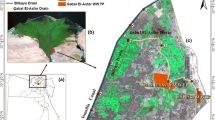Abstract
Coastal lakes are often under the threat of sea water ingress causing the depletion of fresh water bodies. Salinization due to sea water ingress causes impact on water resources especially in coastal areas. Thus there is scarcity of fresh water in this region. Climate change causes rise in sea level and this leads to increase of salinity in coastal lakes. Satellite imagery analysis now plays a prominent role in the quick assessment of water quality in a vast area. This study is an attempt to assess the extent of a lake system affected by sea water (Akkulam-Veli lake, Kerala, India) using Indian Remote Sensing Satellite, IRS P6 LISS III imagery. Field data were collected on the date of the satellite overpass. Simple regression equation using radiance in red band is found to yield superior results for the prediction of sodium content whereas polynomial equation using radiance of red band is found to yield superior results for the prediction of chloride content than the simple and multiple regression equations using spectral ratios and radiance from the individual bands from satellite imagery. The refractive index of water containing sodium chloride is more when compared with that of fresh water and this in turn results in high reflection of visible light in the red band when compared to blue and green bands. Hence the radiance of red band gives direct measure of sodium and chloride in lake water. IRS P6-LISS III imagery can be effectively used for the assessment of sea water affected area of the lake system.






Similar content being viewed by others
References
APHA (2005) Standard methods for the examination of water and waste water, 21st edn. American Public Health Association, Washington
Chipman JR, Kiefer R, Lillesand T (2004) Remote sensing. In: Dorf R (ed) The engineering handbook, 2nd edn. CRC Press, Boca Raton
Dekker AG, Peters SWM (1993) The use of Thematic Mapper for the analysis of eutrophic lakes: a case study in the Netherlands. Int J Remote Sens 14:799–821
Dewidar KH, Khedr AA (2005) Remote sensing of water quality for Burullus Lake, Egypt. Geocarto Int 20(3):43–49
EPA (2010) Climate change-Health and environmental effects. www.epa.gov/climatechange/effects/coastal/index.htm, accessed on 25-12-2010
Gitelson A, Garbuzov G, Szilagyi F, Mittenzwey KH, Karnieli K, Kaiser A (1993) Quantitative remote sensing methods for real time monitoring of inland water quality. Int J Remote Sens 14:1269–1295
Glardino C, Bresciani M, Villa P, Martinelli A (2012) Application of remote sensing in water resource management: the case study of Lake Trasimeno, Italy. Water Resour Manag 24(14):3885–3898
Hem JD (1975) Study and interpretation of the chemical characteristics of natural water. USGS Water Supply Paper, 1473, Washington DC, USA
IPCC, Climate Change (2007) In: Parry ML, Canziani OF, Palutikof JP, van der Linden PJ, Hanson CE (eds) Impacts, adaptation & vulnerability. Contribution of Working Group II to the fourth assessment report of the intergovernmental panel on climate change. Cambridge University Press, Cambridge
Olmanson LG, Bauer ME, Brezonik PL (2008) Development and analysis of a 20-year Landsat water clarity census of Minnesota’s 10,000 lakes. Remote sensing of environment, special issue on monitoring freshwater and estuarine systems
Reddy MA (2001) Text book of remote sensing and geographical information systems. B.S. Publications, Hyderabad
Sharma SK (2008) Influence of sea water ingression: a case study from East coast aquifer in India. 20th Salt Water Intrusion Meeting from 23-27, June at Naples, Florida, USA
Sheela AM, Letha J, Sabu J (2010) Environmental status of a tropical lake system. Environ Monit Assess, Springer, Netherlands 180(1–4):422–449. doi:10.1007/s10661-010-1707-5,3-12-2010
Sheela AM, Letha J, Joseph S (2011) Trophic state index of a lake system using IRS (P6-LISS III) satellite imagery. Environ Monit Assess, Springer, Netherlands 177(1–4):575–592. doi:10.1007/s10661.010-1658-2
Sheela AM, Letha J, Joseph S, Ramachandran KK, Manoj C (2012) Computation of physical characteristics of a lake system using IRS P6 (LISS III) imagery. Int J Appl Earth Obs Geoinform, Elsevier 14(1):221–232. doi:10.1016/j.jag.2011.09.013
Zhang X, Hu L, He M (2009) Scattering by pure sea water: effect of salinity. Optics InfoBase, Optics Express 17(7):5698–5710
Acknowledgments
The first author is grateful to Kerala State Pollution Control Board, College of Engineering, Thiruvananthapuram, and Department of Environmental Sciences, Department of Statistics, and Department of Geology of the University of Kerala, and Centre for Earth Science Studies, Thiruvananthapuram for providing all help in this study. The first author is also grateful to Dr. Manoj Chacko, Lecturer, Department of Statistics and to Mr. Sanalkumar S. P. of the Department of Future Studies of the University of Kerala for the guidance in statistical analysis. The author is thankful to Mr. A. Moses for language correction.
Author information
Authors and Affiliations
Corresponding author
Rights and permissions
About this article
Cite this article
Sheela, A.M., Letha, J., Sabu, J. et al. Detection of Extent of Sea Level Rise in a Coastal Lake System using IRS Satellite Imagery. Water Resour Manage 27, 2657–2670 (2013). https://doi.org/10.1007/s11269-013-0309-0
Received:
Accepted:
Published:
Issue Date:
DOI: https://doi.org/10.1007/s11269-013-0309-0




